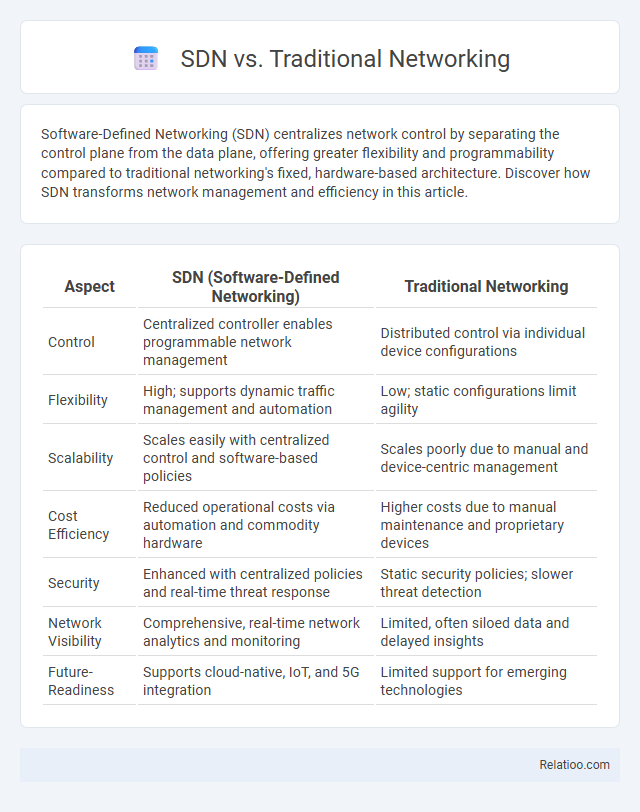Software-Defined Networking (SDN) centralizes network control by separating the control plane from the data plane, offering greater flexibility and programmability compared to traditional networking's fixed, hardware-based architecture. Discover how SDN transforms network management and efficiency in this article.
Table of Comparison
| Aspect | SDN (Software-Defined Networking) | Traditional Networking |
|---|---|---|
| Control | Centralized controller enables programmable network management | Distributed control via individual device configurations |
| Flexibility | High; supports dynamic traffic management and automation | Low; static configurations limit agility |
| Scalability | Scales easily with centralized control and software-based policies | Scales poorly due to manual and device-centric management |
| Cost Efficiency | Reduced operational costs via automation and commodity hardware | Higher costs due to manual maintenance and proprietary devices |
| Security | Enhanced with centralized policies and real-time threat response | Static security policies; slower threat detection |
| Network Visibility | Comprehensive, real-time network analytics and monitoring | Limited, often siloed data and delayed insights |
| Future-Readiness | Supports cloud-native, IoT, and 5G integration | Limited support for emerging technologies |
Introduction to SDN and Traditional Networking
Software-Defined Networking (SDN) transforms traditional networking by decoupling the control plane from the data plane, enabling centralized management and programmability of your network infrastructure. Traditional networking relies on distributed control mechanisms embedded within individual devices, leading to complex configuration and limited flexibility. SDN offers enhanced agility and scalability by allowing dynamic network adjustments through software, unlike static traditional networks that require manual interventions.
Core Architecture Differences
Software-Defined Networking (SDN) separates the control plane from the data plane, centralizing network intelligence and enabling programmability through a centralized controller. Traditional networking integrates control and data planes within each device, leading to decentralized management and slower configuration changes. Your network architecture benefits from SDN's agility and automation, contrasting with the static, device-centric approach of traditional networks.
Control and Data Plane Separation
Software-Defined Networking (SDN) distinctly separates the control plane from the data plane, centralizing network intelligence and decision-making in a controller, while traditional networking integrates both planes within individual devices. This separation in SDN allows for dynamic, programmable control, improving network flexibility and management compared to the static, device-based control in traditional networks. Your network benefits from this clear division by enabling more efficient traffic management, simplified policy enforcement, and faster innovation cycles.
Hardware and Software Requirements
Software-Defined Networking (SDN) centralizes control by separating the control plane from the data plane, requiring programmable hardware such as OpenFlow-enabled switches and a robust controller software platform for dynamic network management. Traditional networking relies heavily on specialized, vendor-specific hardware with integrated control and data planes, demanding significant investment in proprietary routers and switches with limited flexibility. Hybrid networking combines aspects of both approaches, utilizing conventional hardware for stable data forwarding while integrating SDN controllers to optimize traffic flow through software-driven policies.
Network Management and Automation
Traditional networking relies heavily on manual configuration and static device management, limiting scalability and operational efficiency. Software-Defined Networking (SDN) centralizes network control through programmable controllers, enhancing automation, real-time policy enforcement, and simplified management. Your network management benefits from SDN's dynamic automation capabilities, reducing human error and accelerating deployment compared to conventional networking methods.
Scalability and Flexibility
Software-Defined Networking (SDN) offers superior scalability and flexibility compared to traditional networking by centralizing control and enabling dynamic traffic management through programmable interfaces. Traditional networking relies on hardware-based configurations, limiting your network's ability to rapidly adapt and scale efficiently in response to changing demands. Hybrid network environments combining SDN and traditional elements provide a balanced approach, optimizing both flexibility and scalability for diverse enterprise needs.
Security Considerations
Software-Defined Networking (SDN) enhances security by centralizing network control, allowing dynamic policy enforcement and rapid threat detection compared to Traditional Networking's static, hardware-centric approach. Traditional networks often struggle with isolated device configurations, making consistent security management challenging, while SDN's programmable nature enables automated response to vulnerabilities across the entire network. Your security posture benefits from SDN's visibility and flexibility, which reduce attack surfaces and improve incident response times compared to conventional network architectures.
Cost Implications
Software-Defined Networking (SDN) significantly reduces operational expenses by centralizing network management and automating configuration, minimizing manual intervention and downtime compared to Traditional Networking. Traditional Networking incurs higher capital expenditures due to the need for proprietary hardware and complex, device-specific configurations, increasing both initial investment and ongoing maintenance costs. Network cost implications further include scalability challenges, where SDN offers greater cost-efficiency in expanding infrastructure through virtualized resources, while traditional setups require costly physical upgrades.
Use Cases and Applications
Software-Defined Networking (SDN) enables dynamic, programmatically efficient network management ideal for cloud computing, data centers, and large-scale enterprises requiring rapid scalability and centralized control. Traditional networking relies on static, hardware-based configurations suitable for simple, stable environments like small offices with limited traffic variations. Network use cases vary from SDN's agility in bandwidth optimization and security policy enforcement to traditional networking's strength in predictable, low-complexity setups.
Future Trends in Networking
Future trends in networking emphasize software-defined networking (SDN) for its centralized control, programmability, and agility, contrasting with traditional networking's static configurations and hardware dependence. SDN facilitates real-time network optimization, enhanced security through micro-segmentation, and seamless integration with cloud-native environments. Emerging technologies like intent-based networking and AI-driven automation further evolve SDN frameworks, pushing network infrastructures towards greater scalability and adaptive performance.

Infographic: SDN vs Traditional Networking
 relatioo.com
relatioo.com